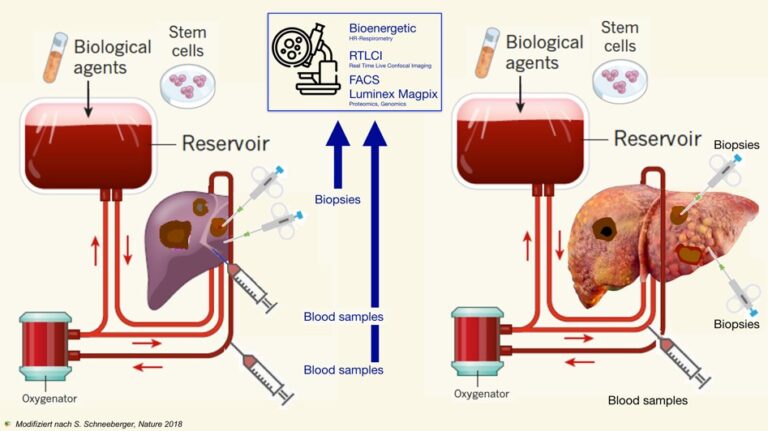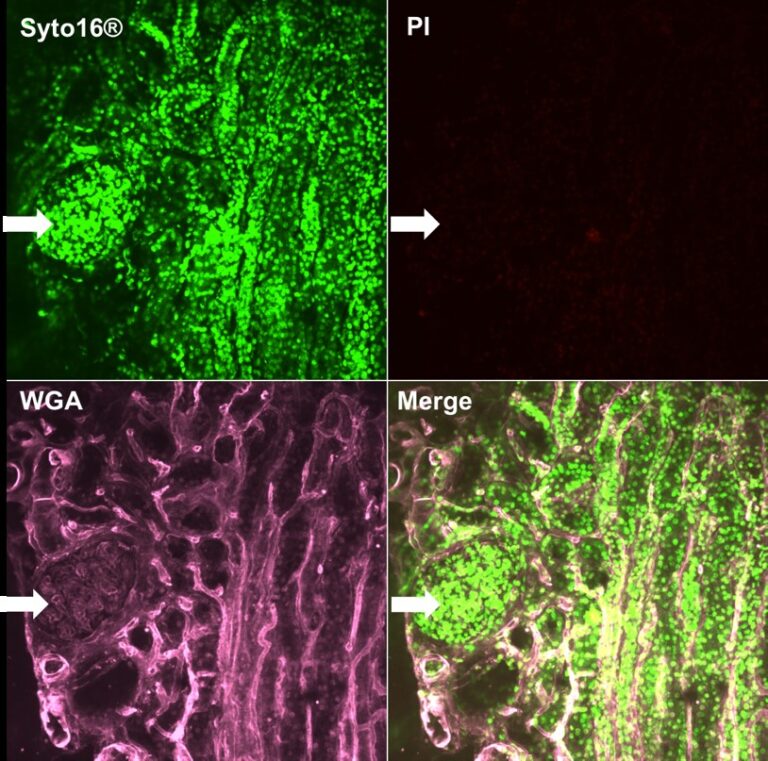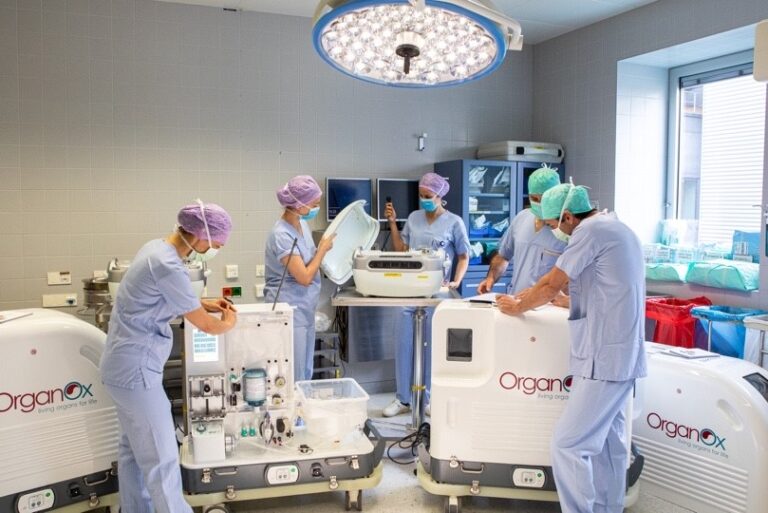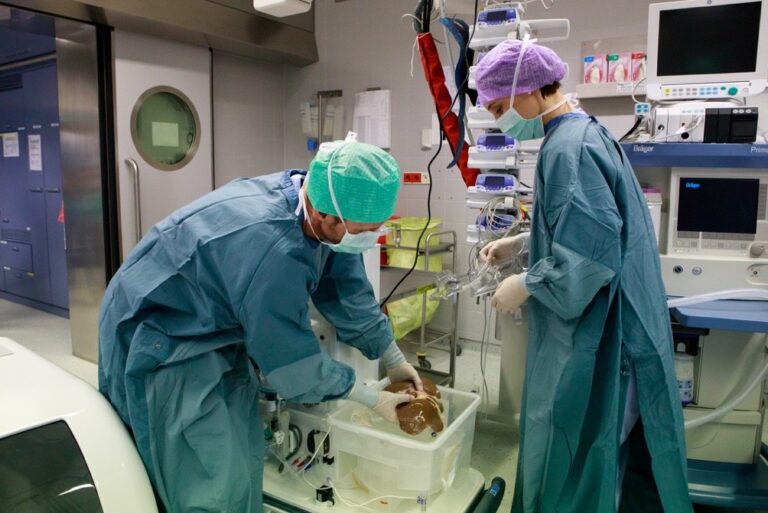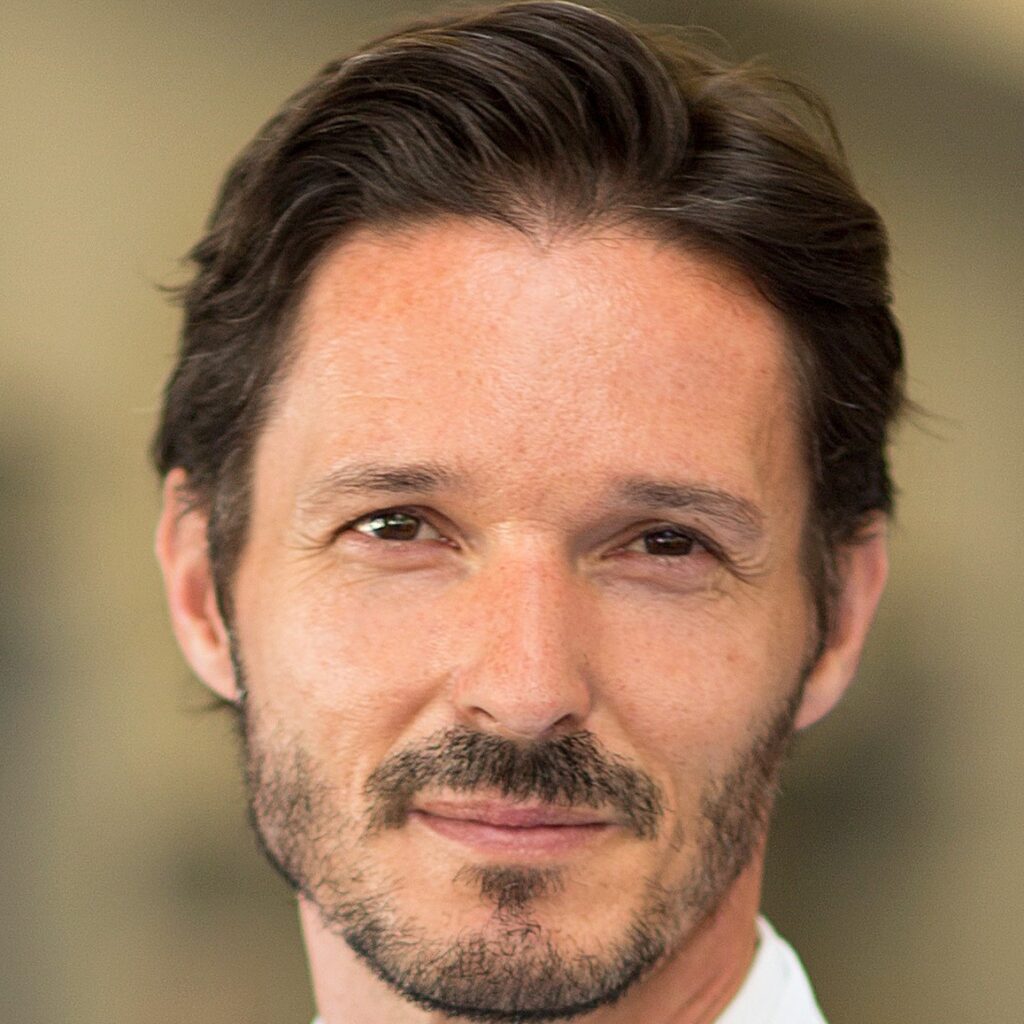
Anichstraße 35
6020 Innsbruck
Email: stefan.schneeberger@i-med.ac.at
Website: https://chirurgie.i-med.ac.at/
Research Branch (ÖSTAT Classification)
106023; 301114, 301904, 302003, 302082, 302083
Keywords
cancer, Inflammation, intracellular signalling, ischemia-reperfusion injury, machine perfusion, mitochondria, molecular oncology, organ preservation, quality assurance in surgery, reactive oxygen species (ROS), Translational Research, transplantation, and transplantation biology
Research Focus
Molecular and Clinical Oncology
Translational research focuses on altered intracellular signalling pathways and their tumorigenic effects, particularly in controlled clinical trials.
Organ Preservation, Transplantation, and Inflammation
Experimental and clinical machine perfusion of organs together with biochemical, functional imaging and bioenergetic assessment (organLifeTM laboratory) serve as a basis for the assessment and treatment of organs during preservation and prior to transplantation. Basic research focuses on strategies to prevent redox associated with early reperfusion.
Quality Assurance in Surgery
Based on the comprehensive, quality-controlled registry with third-party data control, we advance the magnitude and quality of clinical studies and translational research.
General Facts
The Department of Visceral, Transplant and Thoracic Surgery (VTT) maintains an internationally established high-volume adult and paediatric transplant programme that covers all solid organs as well as vascularised composite allografts. The second focus is on oncology, in which we offer solutions for all types of tumours in abdominal, endocrine and breast as well as thoracic surgery. The high-volume cancer care with an international reputation is closely connected with corresponding research programmes and forms part of an auditable quality assurance programme, which additionally represents a third scientific focus. The assessment of molecular events in malignancy and the tumour environment is recognised through the career expertise of Uni. Prof. Jakob Troppmair and his team in the DSL.
Daniel Swarovski Research Laboratory
The Daniel Swarovski Research Laboratory (DSL) was established to add an equally ambitious research focus to the challenging and successful solid organ transplantation programme initiated by Prof. Raimund Margreiter. A common theme of projects in molecular transplantation biology and oncology is the role of intracellular signalling pathways, reactive oxygen species (ROS) and mitochondria in the development of pathological conditions but also as possible targets for therapeutic intervention.
organLifeTM Laboratory
The organLifeTM laboratory serves as a multidisciplinary research core unit for machine perfusion of all organs and as an assessment battery that allows in-depth analysis of organ viability, function and regeneration. Our primary objective is to establish long-term organ preservation.
Research
Clinical Oncology
Team leaders: Univ.-Prof. Dr. Dietmar Öfner-Velano, Assoz. Prof. Priv.-Doz. Dr. Manuel Maglione, Assoz. Prof. Priv.-Doz. Dr. Alexander Perathoner, Priv.-Doz. Dr. Reinhold Kafka-Ritsch, Priv.-Doz.in Dr.in Pamela Kogler, Univ.-Prof. Dr. Stefan Schneeberger
Members of the oncology working group are significantly involved in the planning, development and implementation of national and international clinical studies, which comprise several phase-II and III studies. Further activities include the field of development of prognostic scores (ASPEN study, ASSO pNEN study group), which are validated by international centres. This area of research is rounded off with investigations into the metabolome and IL-37, for better understanding of the regeneration potential of the liver. Examples of academic studies include: DREAM study, European snapshot study, E-MIPS registry, Presepsin study, IOPSH study, SLASA and SOLE study.
Molecular Oncology
Team leaders: Univ. Prof. Dr. Jakob Troppmair, Assoz. Prof. Manuel Maglione, Assoz. Prof. Priv.-Doz. Dr. Florian Augustin, Assoz. Prof. Priv.-Doz. Dr. Rupert Oberhuber, Priv.-Doz.in Dr.in Pamela Kogler, Dr.in Eva Braunwarth, Dr. Stefan Scheidl, Univ.-Prof. Dr. Stefan Schneeberger
Tissue Microarrays and Organoids
Tissue microarrays and organoids from a large cohort of pancreatic, lung and colorectal cancer samples serve as a basis for gaining insights into the molecular aspects of tumour development and progression and upon which to provide better characterisation of the tumour microenvironment (TILs in PDAC study). In cooperation with internal networks, investigations of genetic variations in the highly atherogenic apolipoprotein(a) or immuno-genomic analyses in colorectal cancer serve as examples for additional projects conducted at MUI as well as for studies on transcription factors, adhesion molecules, cytokines and mitochondrial metabolic phenotyping.
Preventing Malignant Transformation and Regulation of Tumour Growth
Progress in cancer treatment is expected from improved treatment regimens, and alternative targets are currently seen in metabolic alterations that allow tumour cells to adapt to increasing and changing needs. Altered ROS production in tumour cells drives tumour progression. Recent work leads us to propose a novel tumour suppressor pathway consisting of JNK/PKCß/p66Shc with a central role in mitochondrial ROS production. Current research efforts aim at restoring p66Shc function to overcome drug resistance in BRAF-mutated cancers.
Tumour Immuno-morphological Studies in Machine-Perfused Livers with Metastasis
Livers affected by metastasis of colorectal cancer will be perfused with blood for several days after curative resection in collaboration with the Department of Haemato-Oncology and the DSL. This will provide the unique opportunity to study single-cell tumour behaviour live and ultimately to test the efficacy of modification and treatment under human-like conditions. In this model, we will also assess RAF and MEK, ERK1/2, RKIP and miR-23a regulation and the effect of interference with these and other mechanisms in immuno-oncology.
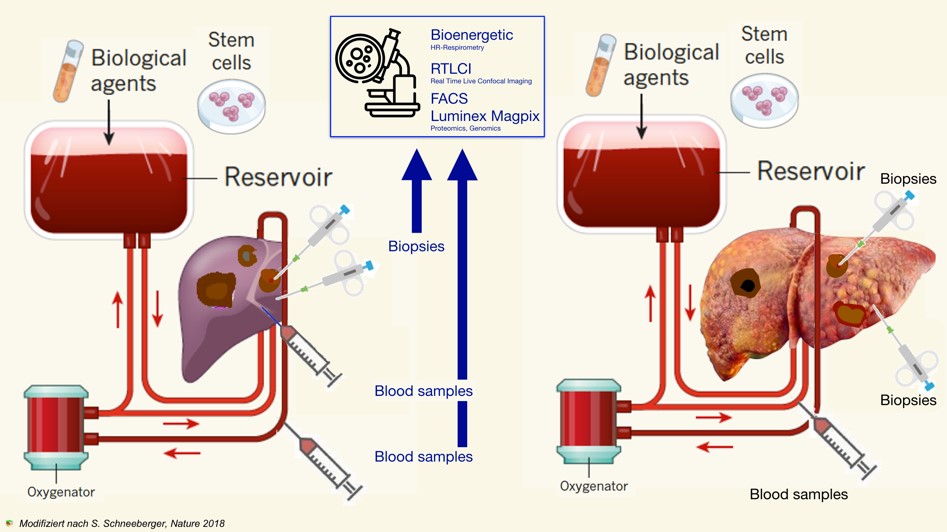
Research Focus: Organ Preservation, Transplantation and Inflammation
Leaders: Univ.-Prof. Dr. Stefan Schneeberger, Prof.in Priv. Doz.in Dr.in Annemarie Weissenbacher, Assoz. Prof. Priv.-Doz. Dr. Manuel Maglione, Assoz. Prof. Priv.-Doz. Dr. Rupert Oberhuber, Priv.-Doz.in Dr.in Theresa Hautz, Priv. Doz. Dr. Thomas Resch, Dr. Benno Cardini.
The focus of both clinical and experimental research is on improving understanding and finding ways to prevent or ameliorate I/R injury. Our clinical trials have shown a significant impact of I/R injury on the transplantation outcome and have identified the value and significance of real-time confocal microscopy (RTCM) and respirometry as tools to assess both damage prior to transplantation and outcome after transplantation.
I/R Injury in VCA
We recently carried out the first in-depth analysis of tissue damage induced by I/R injury in rodent models and tested the effect of novel preservation solutions on the prevention of I/R injury. Muscle is the tissue that is most affected by I/R in vascularised composite graft. We found histomorphological signs of regeneration in the musculature, indicating natural regenerative potential in this model.
Preventing Ischaemia-Reperfusion Injury (IRI)
The production of ROS on initiation of reperfusion is responsible for many cellular events, ultimately resulting in the manifestation of IRI. In order to control excessive ROS production, our focus is on controlling p66Shc expression, for which we have dissected the signalling pathways that regulate activation. Our current emphasis is on the comparison of JNK1/2 and PKCß in their relevance and contribution to the development of IRI through p66Shc-dependent and independent pathways. In collaboration with Prof. Stefan Schneeberger, we have also begun to include human material in our research and especially samples from long-term perfused organs. Initial results provide evidence for the involvement of the JNK/PKCß/p66Shc axis in the transition from ischemia to reperfusion in human liver transplants.
Machine Perfusion Programme
Our aim is the targeted treatment of damaged organs, in order to restore functionality. Together with a comprehensive collection of technologies and instruments for in-depth analysis of tissue and perfusate composition, molecular biological morphology, viability and bioenergetic function, our setup is ideally suited both to the assessment of machine-perfused organs used in our clinical work and to experimental studies.
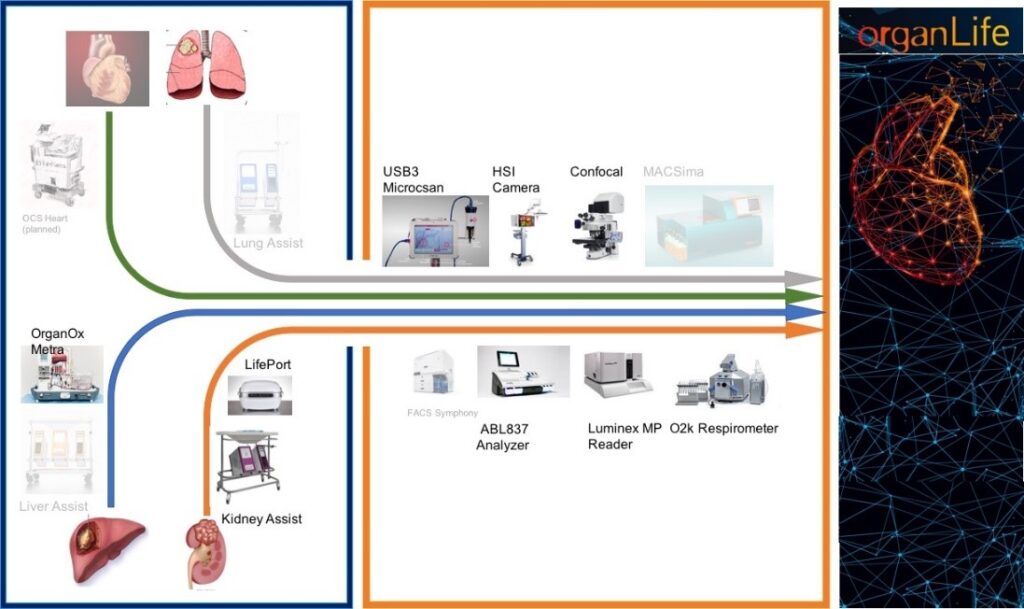
Clinical Kidney Preservation and Machine Perfusion Trials
In a prospective clinical trial, kidney transplant recipients were investigated for the development of delayed graft function. A real-time confocal microscopy score was found to be significantly lower in kidneys developing DGF compared with no DGF (p=0.01), whereas the commonly used Remuzzi score of p = 0.13 did not differ between DGF and no DGF.
In a subsequent study, we assessed 103 hypothermic machine perfusion (HMP) and 103 SCS instances in a propensity score (PS) matched study. The DGF rate was 64.1% for SCS compared with 31.1% following HMP, which is equivalent to a 51.5% reduction in the DGF rate. DGF was associated with decreased 1 and 3-year graft survival (p = 0.001 and p = 0.008) or a 4.1-fold increased risk of graft failure (HR = 4.108; 95% CI: 1.336 – 12.631; p = 0.014). In summary, this study illustrated that HMP significantly reduces DGF in kidney transplantation.
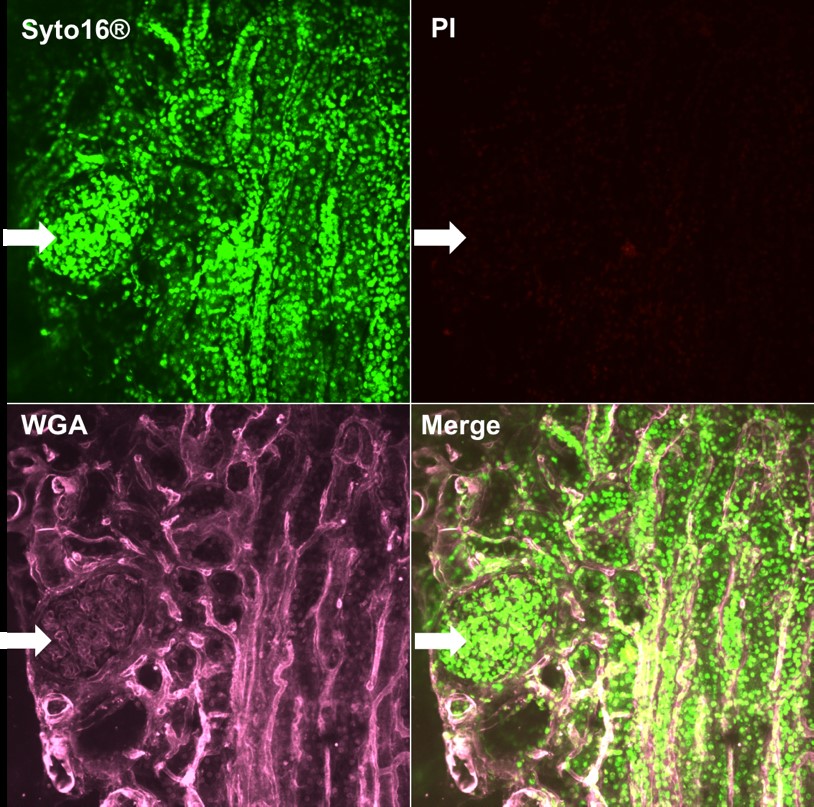
Clinical Liver Preservation and Machine Perfusion Trials
We conducted two large clinical I/R trials in liver transplantation with the aims of establishing a rapid assessment tool for donor liver quality and investigating its predictive value for clinical use. For both RTCM and mitochondrial respiration, we found strong correlations with early allograft dysfunction after liver transplantation.
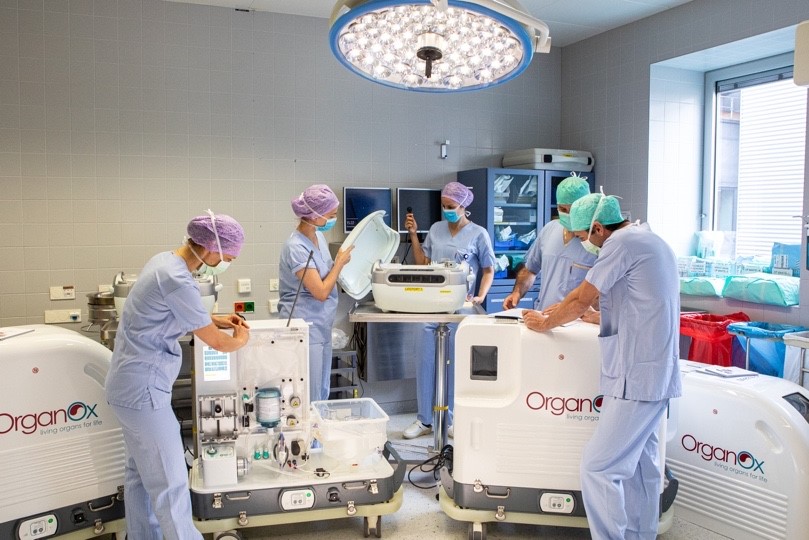
In a comprehensive study, we analysed 50 livers during machine perfusion and transplantation. Although data analysis is ongoing, we can see clear dynamics during machine perfusion and strong correlations with the outcome.
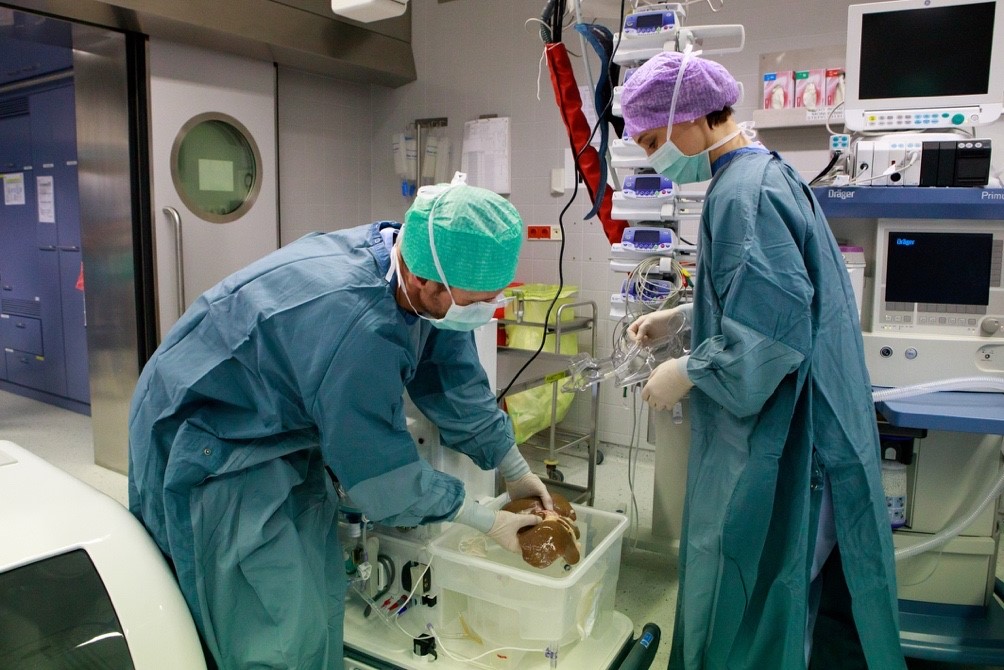
Tetrahydrobiopterin in Experimental Organ Transplantation
Tetrahydrobiopterin is a naturally-occurring, potent antioxidative agent as well as an essential co-factor for a set of 8 different enzymes, including the three nitric oxide synthase (NOS) isoforms (neuronal, endothelial and inducible). The immunomodulatory properties of tetrahydrobiopterin were identified in experimental transplant models and in a brain death model in mice. The mechanisms are specific to tetrahydrobiopterin and not related to its antioxidative properties.
The target molecule of exogenous tetrahydrobiopterin in the prevention of acute rejection remains elusive. Currently funded projects focusing on acute rejection clearly describe a different immuno-protective mechanism in comparison with that of classic immunosuppressive agents, e.g., such as calcineurin inhibitors. Analyses of secondary lymphoid organs, serum and tissue specimens indicate strong manipulation of the innate immune response following organ transplantation, which in turn has a decisive influence on adaptive immune response.
Research Focus: Inflammation and Sepsis
Leader: Priv.-Doz. Dr. Reinhold Kafka-Ritsch, Assoz. Prof. Priv.-Doz. Dr. Alexander Perathoner
The main focus is on the development of new strategies for the treatment of abdominal sepsis. We have developed a damage control concept using abdominal vacuum therapy to treat abdominal sepsis in patients, which has been proved at least in an in-house controlled randomised trial. Our current focus of investigation is on the feasibility and side effects of bowel preparation and preoperative oral antibiotics. Studies of the micro and mycobiome are ongoing. HPV infection, complex anal fistulae and radiation proctitis represent focuses of the coloproctology group and are being evaluated in clinical trials (INSPIRE trial, MiFlaPro trial).
Research Focus: Quality Assurance in Surgery
Leader: Prof. Dr. Dietmar Öfner-Velano, MAS, MSc
Based on over 20 years of experience, a digital, proprietary quality-assurance programme has been established, which provides quality-controlled, audit-ready data in routine clinical practice with no significant additional effort. Comprising more than 110,000 unique patient records, this registry-embedded clinical trial is a unique feature of the department and has already been proven to be an indispensable quality-assured database for several retrospective studies, including diploma theses. The qcRegistry itself is also the object of research with respect to its implementation in daily practice, user-friendliness and the effects on treatment pathways, to name but a few. In the near future, investigations will be conducted to examine how the plethora of data can be processed using machine learning. Recent surgical issues, for example, have been addressed in the global collaboration with GlobalSurg, especially with COVIDSurg using these data in 2020.
Pictures
Selected Publications
Fodor, M.; Cardini, B.; Peter, W.; Weissenbacher, A.; Oberhuber, R.; Hautz, T.; Otarashvili, G.; Margreiter, C.; Maglione, M.; Resch, T.; Krendl, F.; Meszaros, A. T.; Bogensperger, C.; Gasteiger, S.; Messner, F.; Henninger, B.; Zoller, H.; Tilg, H.; Öfner, D.; Schneeberger, S.: Static cold storage compared with normothermic machine perfusion of the liver and effect on ischaemic-type biliary lesions after transplantation: a propensity score-matched study. BRITISH JOURNAL OF SURGERY. 2021; 108(9); 1082-1089
Meszaros, AT.; Hofmann, J.; Buch, ML.; Cardini, B.; Dunzendorfer-Matt, T.; Nardin, F.; Blumer, MJ.; Fodor, M.; Hermann, M.; Zelger, B.; Otarashvili, G.; Schartner, M.; Weissenbacher, A.; Oberhuber, R.; Resch, T.; Troppmair, J.; Öfner, D.; Zoller, H.; Tilg, H.; Gnaiger, E.; Hautz, T.; Schneeberger, S.: Mitochondrial respiration during normothermic liver machine perfusion predicts clinical outcome. EBIOMEDICINE. 2022; 85; 104311.
Fodor, M.; Salcher, S.; Gottschling, H.; Mair, A.; Blumer, M.; Sopper, S.; Ebner, S.; Pircher, A.; Oberhuber, R.; Wolf, D.; Schneeberger, S.; Hautz, T.: The liver-resident immune cell repertoire – A boon or a bane during machine perfusion? FRONTIERS IN IMMUNOLOGY. 2022; 13(S); 982018.
Resch, T.; Hackl, H.; Esser, H.; Günther, J.; Schwelberger, H.; Ritschl, PV.; Ebner, S.; Maglione, M.; Mellitzer, V.; Biebl, M.; Öllinger, R.; Zoller, H.; Schneeberger, S.; Kotsch, K.: Expression of MICA in Zero Hour Biopsies Predicts Graft Survival After Liver Transplantation.
FRONTIERS IN IMMUNOLOGY. 2021; 12; 606146.
Messner, Franka; Thurner, Marco; Mueller, Jule; Blumer, Michael; Hofmann, Julia; Marksteiner, Rainer; Couillard-Despres, Sebastien; Troppmair, Jakob; Öfner, Dietmar; Schneeberger, Stefan; Hautz, Theresa: Myogenic progenitor cell transplantation for muscle regeneration following hindlimb ischemia and reperfusion.
STEM CELL RESEARCH & THERAPY. 2021; 12(1); 146.
Selection of Funding
- FWF Project I 5177-B Mitochondrial dysfunction in ACM pathogenesis. (Jakob Troppmair)
- EU funded Project Interreg INCardio (Manuel Maglione, Jakob Troppmair)
- In Memoriam Dr. Gabriel Salzner Stiftung: P001 Normothermic Liver Preservation and Conditioning Trial. (Stefan Schneeberger)
- MUI Start: 2018-10-009 Detection of markers for liver function and regeneration during liver perfusion using the OrganOx metra® device. (Annemarie Weissenbacher)
- TWF: UNI-0404/Role of donor-derived leukocytes in perfusate during machine perfusion of human liver allografts. 2360 (Theresa Hautz-Neunteufel)
- ÖNB 17287Assessment of the liver quality prior to trans-plantation by life confocal imaging and cytokine expression profiling. (Rupert Oberhuber)
Collaborations
- Peter J. Friend, Rutger Ploegh, University of Oxford, Nuffield Department of Surgical Sciences, Oxford, United Kingdom
- Keith M. Channon, University of Oxford, Division of Cardiovascular Medicine, Radcliffe Department of Medicine, Wellcome Trust Centre for Human Genetics, Oxford, United Kingdom
- Darius Mirza, University Hospitals Birmingham, Liver and Hepato-Pancreato-Biliary (HPB) Unit, Birmingham, United Kingdom
- Gerald Brandacher, Johns Hopkins Medical University, Department of Plastic Surgery, Baltimore, USA
- Hans Schlitt, Universitätsklinikum Regensburg, Klinik und Poliklinik für Chirurgie, Regensburg, Germany
- Stuart Forbes, Institute for Regeneration and Repair, Center for Regenerative Medicine, University of Edinburgh, Scottland
- Kurt Werner Schmid, Universitätsklinikum Essen, Institut für Pathologie, Essen, Germany
- Emmanuel Morelon, Hospices Civils de Lyon, Hospital Edouard Herriot – Transplantation, néphrologie et immunologie, Lyon, France
- Emmanouil S.Papadakis, Graham Packham, Ramsey Cutress, Cancer Research UK Centre, Cancer Sciences Division, University of Southampton Faculty of Medicine, Southampton General Hospital, Southampton, United Kingdom
- Andrew Cato, Karlsruhe Institute of Technology, Institute of Photon and Synchrotron Radiation, Eggenstein-Leopoldshafen, Germany
- Armin Zebisch, Heinz Sill, Division of Hematology, Medical University of Graz, Graz, Austria
- Stefan Wiese, Faculty for Biology and Biotechnology, Group for Molecular Cell Biology, Ruhr University Bochum, Bochum, Germany
- Eduard Stefan, Institute of Biochemistry and Center for Molecular Biosciences, University of Innsbruck, Innsbruck, Austria
